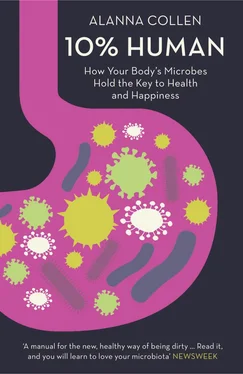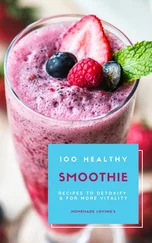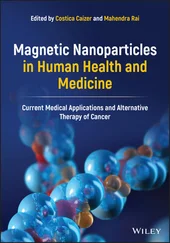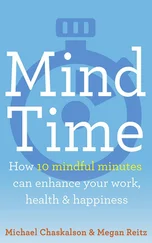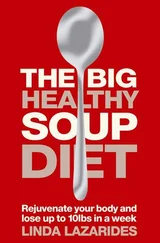It was by using germ-free mice that the commander-in-chief of microbiome science, Professor Jeffrey Gordon from the University of Washington in St Louis, Missouri, discovered a remarkable indication of just how fundamental the microbiota are to the running of a healthy body. He compared the guts of germ-free mice with those of conventional mice, and he learnt that under the direction of bacteria the mouse cells lining the gut wall were releasing a molecule that ‘fed’ the microbes, encouraging them to take up residence. The presence of a microbiota not only changes the chemistry of the gut, but also its morphology. The finger-like projections grow longer at the insistence of microbes, making the surface area large enough to capture the energy it needs from food. It’s been estimated that rats would need about 30 per cent more to eat if it weren’t for their microbes.
It is not only microbes that are benefiting from sharing our bodies, but us too. Our relationship with them is not just one of tolerance, but encouragement. This realisation, combined with the technical power of DNA sequencing and germ-free mouse studies, began a revolution in science. The Human Microbiome Project, run by the United States’ National Institutes for Health, alongside many other studies in laboratories around the world, has revealed that we utterly depend on our microbes for health and happiness.
The human body, both inside and out, forms a landscape of habitats as diverse as any on Earth. Just as our planet’s ecosystems are populated by different species of plants and animals, so the habitats of the human body host different communities of microbes. We are, like all animals, an elaborate tube. Food goes in at one end of the tube and comes out the other. We see our skin as covering our ‘outside’ surface, but the inner surface of our tube is also ‘outside’ – exposed to the environment in a similar way. Whilst the layers of our skin protect us from the elements, invading microbes and harmful substances, the cells of the digestive tract that runs right through us must also keep us safe. Our true ‘inside’ is not this digestive tract, but the tissues and organs, muscles and bones that are packed away between the inside and the outside of our tubular selves.
The surface of a human being, then, is not just their skin, but the twists and turns, furrows and folds of their inner tube as well. Even the lungs, the vagina and the urinary tract count as being on the outside – as part of the surface – when you view the body in this way. No matter if it’s inner or outer, all of this surface is potential real estate for microbes. Sites vary in their value, with dense city-like communities building up in resource-rich prime locations like the intestines, while sparser collections of species occupy more ‘rural’ or hostile locations such as the lungs and the stomach. The Human Microbiome Project set out to characterise these communities, by sampling microbes from eighteen sites across the inner and outer surfaces of the human body, in each of hundreds of volunteers.
Over the first five years of the HMP, molecular microbiologists oversaw a biotechnological echo of the golden age of species discovery; one that saw formaldehyde-infused collecting cabinets stuffed with the haul of birds and mammals discovered and named by explorer– biologists in the eighteenth and nineteenth centuries. The human body is, as it turns out, a treasure trove of strains and species new to science, many of them present on only one or two of the volunteers participating in the study. Far from each person harbouring a replicate set of microbes, very few strains of bacteria are common to everyone. Each of us contains communities of microbes as unique as our fingerprints.
Though the finer details of our inhabitants are specific to each of us, we all play host to similar microbes at the highest hierarchical levels. The bacteria living in your gut, for example, are more similar to the bacteria in the gut of the person sitting next to you, than they are to the bacteria on your knuckles. What’s more, despite our distinctive communities, the functions they perform are usually indistinguishable. What bacterium A does for you, bacterium B might do for your best friend.
From the arid, cool plains of the skin on the forearms to the warm, humid forests of the groin and the acidic, low-oxygen environment of the stomach, each part of the body offers a home to those microbes that can evolve to exploit it. Even within a habitat, distinct niches host different collections of species. The skin, all two square metres of it, contains as many ecosystems as the landscapes of the Americas, but in miniature. The occupants of the sebum-rich skin of the face and back are as different from those of the dry, exposed elbows as the tropical forests of Panama are from the rocks of the Grand Canyon. Where the face and back are dominated by species belonging to the genus Propionibacterium , which feed off the fats released by the densely packed pores in these areas, the elbows and forearms host a far more diverse community. Moist areas, including the navel, the underarms and the groin, are home to Corynebacterium and Staphylococcus species, which love the high humidity, and feed off the nitrogen in the sweat.
This microbial second skin provides a double layer of protection to the body’s true interior, reinforcing the sanctity of the barrier formed by the skin cells. Invading bacteria with malicious intentions struggle to get a foothold in these closely guarded bodily border towns, and face an onslaught of chemical weapons when they try. Perhaps even more vulnerable to invasion are the soft tissues of the mouth, which must resist colonisation by a flood of intruders smuggled on food and floating in the air.
From the mouths of their volunteers, researchers working on the Human Microbiome Project took not just one sample, but nine, each from a slightly different location. These nine sites turned out to have discernibly different communities, within mere centimetres of one another, made up of around 800 species of bacteria dominated by Streptococcus species and a handful of other groups. Streptococcus gets bad press, on account of the many species that cause diseases, from ‘strep throat’ to the flesh-eating infection necrotising fasciitis. But many other species in this genus behave themselves impeccably, crowding out nasty challengers in this vulnerable entrance to the body. Of course these tiny distances between sampling locations within the mouth may seem insignificant to us, but to microbes they are like vast plains and mountain ranges with climates as different as northern Scotland and the south of France.
Imagine, then, the climatic leap from the mouth to the nostrils. The viscous pool of saliva on a rugged bedrock replaced by a hairy forest of mucus and dust. The nostrils, as you might expect from their gatekeeper status at the entrance to the lungs, harbour a great range of bacterial groups, numbering around 900 species, including large colonies of Propionibacterium , Corynebacterium , Staphylococcus and Moraxella .
Heading down the throat towards the stomach sees the enormous diversity of species found in the mouth drop dramatically. The highly acidic stomach kills many of the microbes that enter with food, and just one species is known for certain to reside there permanently in some people – Helicobacter pylori , whose presence may be both a blessing and a curse. From this point on, the journey through the digestive tract reveals an ever-greater density – and diversity – of microbes. The stomach opens into the small intestine, where food is rapidly digested by our very own enzymes and absorbed into the bloodstream. There are still microbes here though; around ten thousand individuals in every millilitre of gut contents at the start of this 7-m-long tube, rising to an incredible ten million per millilitre at the end, where the small intestine meets the large intestine’s starting point.
Читать дальше
